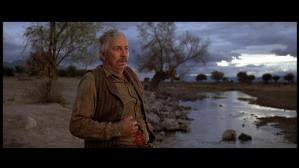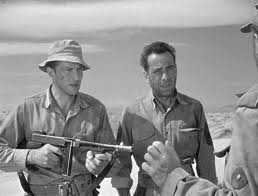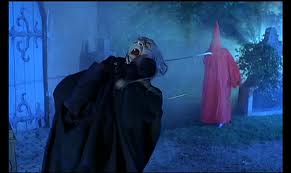The good news is, this lady is going to be your uninvited houseguest:
The bad news is, she's bringing her gang of jewel thieves with her including this guy:
The guest of honor/boss of the gang will not be showing up until later, but don't worry, the guests will come up with interesting ways of entertaining themselves until his arrival.
The Killers are our Guests is one unique and satisfying mixed cocktail from the heyday of Italian cinema. It's one part heist film, two parts home invasion, and one part giallo with the requisite splash of J & B on the side. The hybrid plot is logically structured, well edited and makes complete sense in the end but is still unpredictable. The story, which moves quickly through a somewhat fouled-up heist, takes its time once the gang busts into a doctor's house to seek help for a wounded member. As the thieves get their compatriot patched up and await the arrival of their ringleader, we begin to learn a little bit about them and their unwilling hosts. For example, gun moll Margaret Lee is a take charge kind of gal with a penchant for the ladies. Scary goon Mario, played by Giuseppe Castellano, is a 'punch first and ask questions later' type, who coincidentally, also has a penchant for the ladies. Anthony Steffen, as Doctor Guido Malerva, is quite the hapless milquetoast, and sadly, does not have a way with the ladies (or does he?). There's also the good doctor's wife, Mara Malerva (Livia Cerini), who is a complete ball-buster and appears to be wearing some kind of molestation magnet under her clothing which keeps drawing unwanted (or very wanted) attention to her. Not in attendance, because he's working on solving the heist, is Commissioner Di Stefano played by Luigi Pistilli who in addition to being a world-class detective, rocks some impressive werewolf-like lamb-chops.
I had low expectations for this film because it's pedigree doesn't look very good. The director, Vincenzo Rigo, has only three films on his resume (one of which stars Harry Reems). One co-writer, Renato Romano, is a character actor whose only writing credit is this film. The other co-writer, Bruno Fontana, is responsible for stuff like Escape from Women's Prison and Emanuelle, Queen of the Desert. The main reason the film caught my attention was it starred Margaret Lee and Luigi Pistilli.
Upon viewing, I was so happy to see Lee play a character that wasn't just a pretty face. She is actually the star of the film, and her character is the driving force behind the plot. Dressed all in black, she looks super sexy, like an Emma Peel gone bad. As attractive as she is, she's still completely believable when she takes command or threatens to shoot someone.
Giuseppe Castellano, who was born to play Thug #2, was excellent as a tough guy who is somehow both impatient and level-headed. Surprisingly, he provides a lot of comic relief without ever jeopardizing his tough guy persona. Anthony Steffen makes is usual bland, ineffectualness work for him as the hapless doctor who is forced to deal, not only with the criminals, but his castrating wife as well. Livia Cerini does an OK job as the shrew spouse, but I think this role really cried out for someone less mousy, like Rosalba Neri. Luigi Pistilli, cool as always, only appears early on and late in the film, but is pivotal and has a strong presence.
Vincenzo Rigo, who did a more than competent job as director, also served as his own cinematographer and editor. His editing was particularly impressive, especially when it came to speeding up or slowing down the pace where appropriate. At the end of the film, he punctuates a long, seemingly needless sequence, with the return of an all-but-forgotten character that really provides a great punchline.
The movie is not a masterpiece, but with a strong star turn by Lee, a solid giallo plot twist and clever reveal at the end, these are some guests you definitely want to invite over.
Score 7.5/10







































